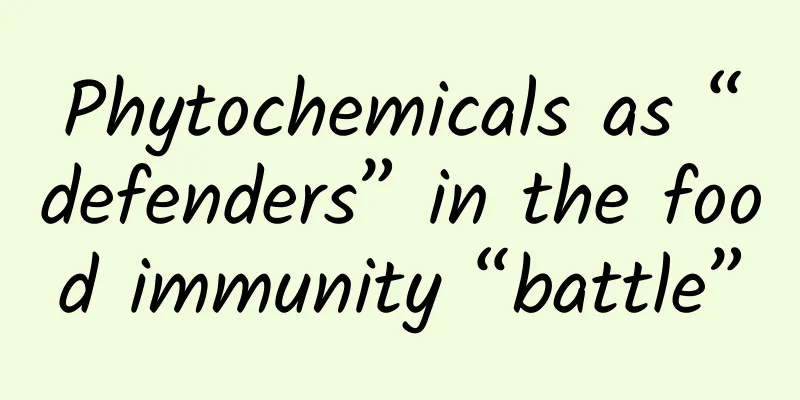Phytochemicals as “defenders” in the food immunity “battle”

|
Food is the best source of immune barrier for the human body, because in addition to containing a variety of nutrients, food also contains many other substances that are beneficial to the human body, such as phytochemicals from plants, which were mostly called non-nutrient bioactive ingredients in the past, mainly including flavonoids, phenolic acids, organic sulfides, terpenoids and carotenoids . Phytochemicals can be called "gifts from plants to humans". They play an important role in maintaining human health, regulating physiological functions, enhancing immunity, resisting infection and preventing diseases. They can effectively enhance human cellular immunity, humoral immunity, nonspecific immunity and immune surveillance. As people pay more attention to and study immunity, sulforaphane and flavonoid compounds in the phytochemical family are gradually emerging. What is Sulforaphane? Sulforaphane is one of the recognized plant active substances with anti-cancer, anti-cancer and cosmetic effects. It can activate the body's self-healing system and detoxification system, regulate the balance of the five internal organs, repair damaged organs, activate a signaling pathway called NRF2 to command human macrophages to remove harmful bacteria from the lungs, and participate in adjusting the outermost immune system (skin) of the human body to enhance the body's immunity. Sulforaphane is an isothiocyanate that is widely found in cruciferous vegetables. The "star" ranking of foods rich in sulforaphane: broccoli, cabbage, beef cabbage, baby spinach, lotus white, broad-leaf mustard greens, Chinese cabbage, kohlrabi, carrots, red radish, green radish, and white radish. What are flavonoids? Flavonoid compounds are a general term for a class of phytochemicals, which can be divided into different subclasses, such as flavonoids, flavonols, anthocyanins, etc. They have the function of protecting cardiovascular health. Many flavonoid components have antitussive, expectorant, antiasthmatic and antibacterial activities. Flavonoids are the most abundant class of polyphenolic compounds in the human diet and are widely found in fruits, vegetables, grains, roots, tea and red wine. Ranking of foods rich in flavonoids: kumquat, mint, rutabaga, olives, lemon, pumpkin, and pitaya. In addition to the above foods, black beans, soybeans, soy milk and soy products, as well as onions, ginkgo leaves, tangerine peel, etc. are also foods rich in flavonoids. Hit the key points Both sulforaphane and flavonoids are phytochemicals that are widely found in various plants, such as vegetables, fruits, and grains. If you want to be healthy, improve your ability to resist viruses, and fight the "defense war" against food epidemics, it is recommended to refer to the recommendations of the Chinese Residents' Dietary Guidelines (2022 edition). Daily meals should include cereals, vegetables, fruits, livestock, poultry, fish, eggs, milk, and legumes. On average, consume more than 12 kinds of food per day, and more than 25 kinds per week, with reasonable combinations. Vegetables should be included in every meal , ensuring that no less than 300g of fresh vegetables are consumed every day, with dark vegetables accounting for 1/2. Fruits should be consumed every day , ensuring that 200-350g of fresh fruits are consumed every day. Juice cannot replace fresh fruits. Eat a variety of dairy products , with the intake equivalent to more than 300ml of liquid milk per day. Eat whole grains and soy products regularly, and eat nuts in moderation . On the basis of a reasonable diet, we should strive to gather more members of the phytochemical family to further enhance our own immunity so that we can better defeat the virus and win the food immunity "defense war". Written by: Li Caihong, Chief Nutrition Technician, Nutrition Department, Urumqi First People's Hospital Note: All pictures are from Baidu |
<<: Are men not worthy of using skin care products?
>>: Is drinking milk after eating durian more poisonous than a cobra?
Recommend
The efficacy and function of wild boar fat
The traditional Chinese medicine wild boar fat is...
The efficacy and function of Ganoderma lucidum
Only when we understand the main ingredients of a...
If you are bitten by a dog, this trick can help you counterattack quickly!
Audit expert: Zhu Guangsi Member of Beijing Scien...
The reason I recommend you to eat more pears, just one is enough!
In the golden autumn, the weather is slightly dry...
The efficacy and function of hard nine-son chain grass
There are many kinds of common Chinese medicinal ...
Why haven't we been destroyed yet?
© Video Hive Leviathan Press: When we expand our ...
"China's Sky Eye" has made another important new discovery!
The search for nanohertz gravitational waves is o...
How long does it take to ventilate before moving in? 9 questions about ventilation and formaldehyde removal explained at once
First of all, the most economical and effective w...
Look! There are "white mushrooms" on the ceiling of the subway station...
Have you ever noticed white objects that look lik...
I thought it was a stomach problem, but it turned out to be a myocardial infarction! During the rainy season, be alert to this symptom!
In recent days, at Zhejiang Provincial People'...
Why are we still so keen on “detoxification” today?
In terms of health care, "detoxification&quo...
It turns out there are things that will make you uglier the more you eat!
One minute with the doctor, the postures are cons...
What are the effects of horsewhip herb
The effects of horsewhip tip are: clearing away h...
"Sanxing Village" is not "Sanxingdui", which may solve the mystery of the origin of civilization in the lower reaches of the Yangtze River
On November 18, the much-anticipated Sanxing Vill...
Double "new evidence" support! Good news for melanoma patients!
At the just-concluded 2024 European Society for M...









